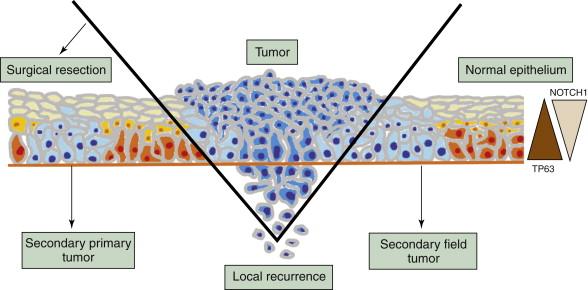Physical Address
304 North Cardinal St.
Dorchester Center, MA 02124
Head and neck squamous cell carcinoma (HNSCC) arises in the oral cavity, oropharynx, hypopharynx, and larynx. It accounts for more than 90% of the cancers of the head and neck and is the sixth most common cancer by incidence worldwide. In the United States, approximately 40,250 new cases of HNSCC were expected in 2012, with the incidence in men being more than twice the incidence in women. Rates of death due to HNSCC have declined only slightly in the United States over the past 3 decades, and the all-stage survival rates of 61% and 50%, at 5 and 10 years, respectively, illustrate the need for improved therapy.
Tobacco use and alcohol consumption are the two most important risk factors for the development of HNSCC, and their contributions to risk are synergistic. In addition, the human papillomavirus (HPV), especially HPV-16, is now a well-established independent risk factor. Present in approximately 20% of all HNSCC, HPV is believed to be responsible for more than 60% of oropharyngeal SCC, specifically, from 2004 to 2008. HPV(+) HNSCC is currently considered, based on clinicopathological and molecular characterizations, to be a unique subtype of HNSCC and has been shown to generally be associated with a favorable prognosis, compared to HPV(−) subtypes. Greatly increased susceptibility to HNSCC is seen in some heritable conditions of impaired genome maintenance, such as Fanconi anemia. The Epstein-Barr virus is a known risk factor for nasopharyngeal carcinoma.
Stage at presentation correlates strongly with prognosis; HNSCC is staged via the tumor, node, metastasis (TNM) staging system. It has also been demonstrated, however, that HPV status and tobacco use are of important prognostic value as well, offering potentially greater predictive value than the traditional TNM staging in the case of oropharyngeal cancers. The field cancerization theory, proposed in 1953 by Slaughter and colleagues to describe the developmental pattern of invasive HNSCC from a precancerous field of atypical mucosal epithelium as depicted in Figure 33-1 , has been implicated in the high incidence of recurrence and second primary tumor formation. Early-stage tumors generally have a favorable prognosis and are treated with surgery or radiotherapy. Advanced-stage tumors are treated with a combination of surgery, radiation, and chemotherapy, with primary surgery for oral cavity tumors followed by adjuvant radiation or chemoradiation, and organ-preservation protocols with combined chemoradiation for pharyngeal and laryngeal cancers. Recently, the use of targeted therapeutics has emerged in HNSCC treatment. The most mature target to date is the epidermal growth factor receptor (EGFR). Anti-EGFR antibodies, in combination with traditional radiotherapy, have demonstrated increased overall survival and progression-free survival in the newly diagnosed setting and improved survival with chemotherapy in the recurrent/metastatic setting.

The well-documented histological progression of HNSCC from oral leukoplakia through progressive phases of hyperplasia, dysplasia, carcinoma in situ, and ultimately invasive carcinoma is believed to correspond with the accumulation of genetic alterations. In HNSCC, one of the earliest initiating events is likely the clonal proliferation of precancerous cells with TP53 mutations. This is followed by the accumulation of additional genetic alterations within clonal subpopulations, in an order that is not well defined and very likely varies among patients. A hypothetical model of development and genetic progression of the primary subtypes of HNSCC is presented in Figure 33-2 . Recently, whole-exome sequencing studies of HNSCC have begun to reveal the genetic underpinnings of this disease. These data, in combination with previous genomic analyses, have identified the most commonly mutated genes in HNSCC as outlined in Table 33-1 .

| Gene ∗ | Description | Mutated (Activating/Missense/Inactivating) |
|---|---|---|
| TP53 a,b | Transcription factor | 53% (NA/28%/25%) |
| CCND1 b | Cell cycle activator (Cyclin D1) | 25% (25%/NA/NA) |
| CDKN2A a,b | Cell cycle inhibitor/p53 activator | 21% (NA/3%/18%) |
| NOTCH1 a,b, ∗ | Receptor/transcription factor | 15% (NA/8%/8%) |
| CSMD3 a,b | Putative adhesion factor | 13% (NA/12%/1%) |
| USH2A a,b | Basement membrane protein | 12% (NA/11%/1%) |
| PIK3CA a,b, ∗ | PI3 kinase catalytic subunit | 10% (7%/7%/NA) |
| PRDM9 b,∗ | Histone methyltransferase | 8% (NA/8%/1%) |
| COL22A1 b, ∗ | Pro-apoptotic effector | 8% (NA/7%/2%) |
| RIMS2 b, ∗ | Putative synaptic vesicle regulator | 8% (NA/8%/NA) |
| ZFHX4 b | Zinc finger homeodomain | 8% (NA/8%/NA) |
| MLL2 b, ∗ | Histone methyltransferase | 8% (NA/4%/4%) |
| NAV3 b | Axonal/cytoskeleton guide | 8% (NA/7%/1%) |
| CASP8 a.b | Pro-apoptotic proteolyase | 7% (NA/2%/5%) |
| TP63 a,b | Transcription factor | 7% (NA/5%/1%) |
| NSD1 b | Histone methyltransferase | 7% (NA/3%/4%) |
| EGFR b | Growth factor Rtk | 7% (7%/NA/NA) |
| PTEN b | Lipid phosphatase—PI3K inhibitor | 6% (NA/3%/3%) |
| FBXW7 a, ∗ | Ubiquitin ligase | 5% (NA/3%/2%) |
| HRAS a,b,∗ | RTK signaling protein | 4% (4%/4%/NA) |
| IRF6 b | Interferon regulatory factor | 4% (NA/3%/1%) |
| NOTCH2 b | Receptor/transcription factor | 4% (NA/3%/1%) |
| NOTCH3 b, ∗ | Receptor/transcription factor | 4% (NA/2%/2%) |
Become a Clinical Tree membership for Full access and enjoy Unlimited articles
If you are a member. Log in here